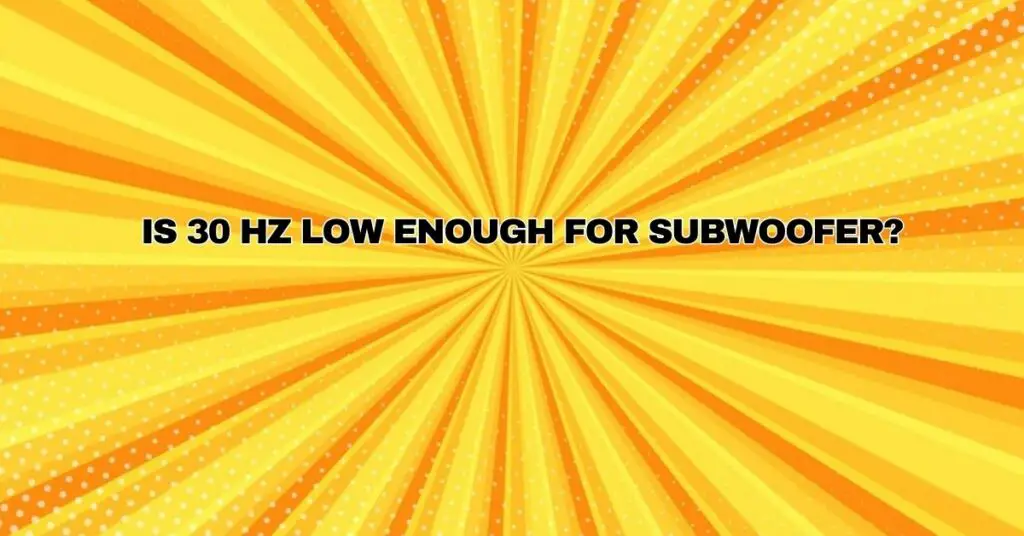Subwoofers are an essential component of any audio system designed to reproduce low-frequency sound. These powerful drivers are responsible for delivering the deep and impactful bass that adds dimension and excitement to music, movies, and other audio content. But when it comes to subwoofer frequencies, many audio enthusiasts and professionals debate the question: Is 30 Hz low enough for a subwoofer to produce the rumbling, visceral bass we crave? In this comprehensive article, we’ll explore the science of subwoofer frequencies, the art of selecting the right frequency range, and the practical considerations that guide the choice of 30 Hz as a subwoofer frequency.
Understanding Subwoofer Frequencies
Subwoofer frequencies, often referred to as “sub-bass,” encompass the extremely low-frequency range of sound. This range is responsible for the rumbling vibrations and deep bass that we feel as much as we hear. Sub-bass frequencies typically span from 20 Hz to 60 Hz, with some subwoofers capable of reaching even lower frequencies.
The Role of Sub-Bass
Sub-bass frequencies serve multiple critical functions in audio:
- Emotional Impact: Sub-bass adds emotional depth to music, contributing to the intensity and mood of a piece. It’s the heartbeat of electronic dance music (EDM) and the dramatic score of a blockbuster film.
- Physical Sensation: Sub-bass creates a tactile sensation, where the vibrations can be felt throughout the body. This sensation can be profoundly immersive in live concerts or home theater experiences.
- Rhythmic Foundation: In music, sub-bass often establishes the rhythm and groove, providing a solid foundation for other instruments to build upon.
Choosing the Right Subwoofer Frequency
The choice of the right subwoofer frequency depends on several factors:
- Musical Genre: Different music genres have varying requirements for sub-bass. For example, EDM and hip-hop rely heavily on sub-bass frequencies below 40 Hz, while classical music or jazz may not require such deep bass.
- Listening Environment: The acoustics of the listening space matter. In a large room with powerful subwoofers, lower sub-bass frequencies may be essential to create a visceral experience. In a smaller room, a balanced approach may be preferred.
- Subwoofer Capabilities: Understanding your subwoofer’s specifications, including its frequency response and capabilities, is crucial. Some subwoofers excel at reproducing frequencies well below 30 Hz, while others may roll off sooner.
- Audience Preferences: Consider the preferences of your intended audience. Some listeners may favor a more prominent and resonant sub-bass, while others may prefer a balanced and controlled low end.
Is 30 Hz Low Enough for a Subwoofer?
The frequency of 30 Hz can be considered sufficiently low for many audio applications. This frequency is well within the sub-bass range and can provide a satisfying, impactful bass experience. In music genres like rock, pop, and some electronic styles, 30 Hz is low enough to create a sense of depth and immersion.
However, whether 30 Hz is low enough for a subwoofer depends on the specific context. In a home theater setup, it might be adequate for most movies and TV shows, where impactful but not extremely deep bass is typically required. In such cases, the goal is often to create a powerful and immersive experience without necessarily delving into the deepest sub-bass frequencies.
For dedicated audio enthusiasts, especially in genres that demand sub-bass frequencies below 30 Hz, a subwoofer capable of reaching even lower frequencies may be preferred. In electronic music, for instance, where sub-bass is a central element, subwoofers that can reproduce frequencies below 30 Hz become essential to capture the full sonic spectrum.
Practical Considerations for Subwoofer Frequency
When setting the subwoofer frequency at 30 Hz, here are some practical considerations:
- Room Acoustics: Take into account the acoustics of your listening environment. Large, open spaces may benefit from a lower subwoofer frequency to fill the room with sound, while smaller rooms may require a more balanced approach.
- Subwoofer Quality: Ensure that your subwoofer is capable of accurately reproducing frequencies at 30 Hz. High-quality subwoofers with the right specifications will provide a more satisfying low-frequency experience.
- Listening Test: Listen to a variety of audio content, including music, movies, and games, to gauge the impact of a 30 Hz subwoofer frequency setting. Adjust as needed to suit your preferences and the specific content you enjoy.
Conclusion
The question of whether 30 Hz is low enough for a subwoofer is a complex one. It depends on a range of factors, including musical genre, listening environment, subwoofer capabilities, and individual preferences. In many cases, 30 Hz is low enough to create a powerful and immersive bass experience, especially in a typical home audio or home theater setup. However, for audiophiles and enthusiasts who demand the deepest sub-bass frequencies for certain music genres, subwoofers capable of reaching even lower frequencies may be preferred. Ultimately, the choice of subwoofer frequency should align with your audio goals and the specific sonic experience you seek to achieve.


